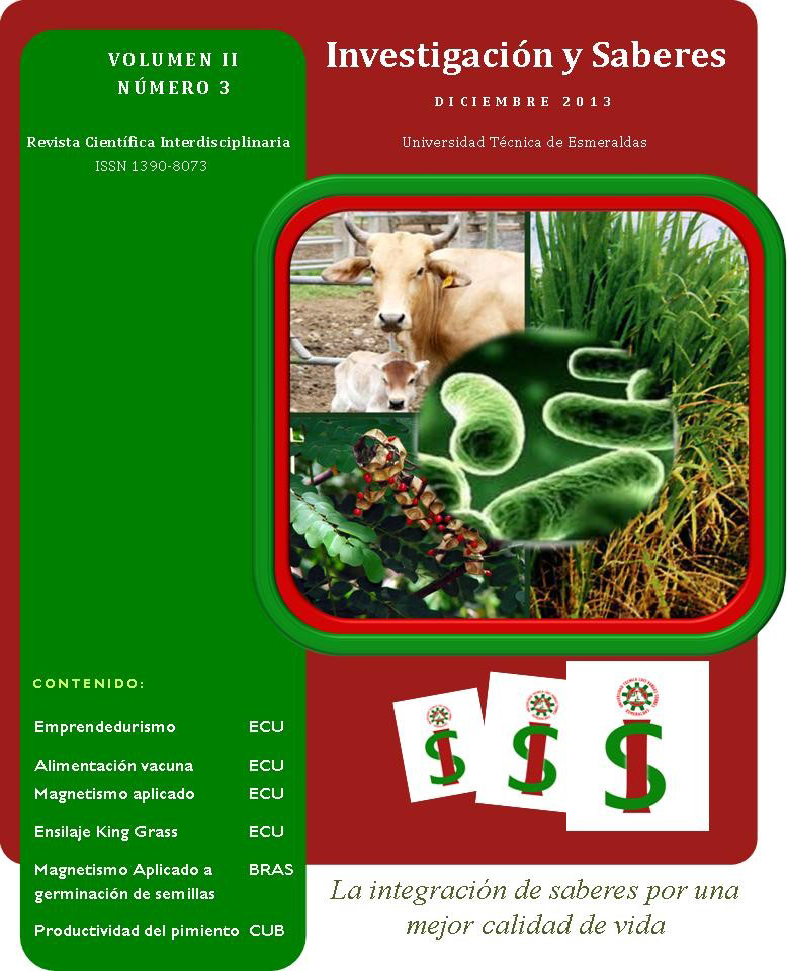Células en cultivo de Lactobacillus Acidophilus bajo la acción un campo electromagnético de fecuencia extremaamente baja
Contenido principal del artículo
Resumen
Para valorar el efecto del campo magnético (CM) sobre la viabilidad de Lactobacillus acidophilus, se expuso un cultivo a un CM de frecuencia extremadamente baja (CMFEB), comparando respecto al correspondiente control, sin tratamiento magnético. Para ello se realizó un diseño experimental D-óptimo con ayuda del paquete estadístico Design Expert (versión 6.0.1). Como variable dependiente se analiza la viabilidad del microorganismo. Se concluye que el CMFEB afectó la viabilidad del microorganismo en los rangos de inducción evaluados (0.1 mT a 0.1 T). El mayor estímulo en cuanto a viabilidad del L. acidophilus (10.71 ufc.mL-1) se logró de 0.5 a 1.2 mT.
Detalles del artículo
Sección
La revista brinda acceso abierto inmediato a todo su contenido sobre el principio de que hacer que la investigación esté disponible de forma gratuita para el público para apoyar un mayor intercambio global del conocimiento.
De esta manera, el lector/a puede acceder a todos los contenidos de la revista desde el momento de la publicación sin coste ni obligación de suscripción.
La revista ienen licencia bajo el acuerdo de licencia internacional Attribution-NonCommercial-ShareAlike 4.0 International (CC BY-NC-SA 4.0). Los/as autores/as retienen los derechos de autor y se permite a terceros copiar, distribuir y hacer uso de los trabajos siempre que cumplan con los términos y condiciones establecidos por dicha licencia
- citar la autoría y la fuente original de su publicación (revista, editorial y URL de la obra).
- No se usen para fines comerciales.
- Si remezcla, transforma o crea a partir del material, deberá difundir sus contribuciones bajo la misma licencia que el original.
Puede encontrar más información al respecto en https://creativecommons.org/licenses/by-nc-sa/4.0/deed.es.
La Revista declina cualquier responsabilidad sobre posibles conflictos derivados de la autoría de los trabajos que se publican.
Cómo citar
Referencias
Campos, J. A. (2002). Cultivos probióticos y protectores, propiedades funcionales (nutracéuticas) de valor agregado en los derivados lácteos. Lácteos y cárnicos mexicanos, (Jun/Jul): 26-37.
Vinderola, C.; Prosello, G. W.; Ghiberto, D. (2000). Viability of probiotic: Bifidobacterium, Lactobacillus acidophilus and Lactobacillus casei and nonprobiotic microflora in Argentinian cheese. Journal of Dairy Science; 83:1905-1911.
Namba, K.; Mohri, K. S. (2000). Effect of electromagnetic field on lactic acid bacteria proliferation. Nippon Shokubutsu Kojo Gakkai Taikai Gakujutsu Koen Yoshishu; 2000: 68-69.
Strašák, L.; Vetter, V.; Fojt, L. (2005). Effects of 50 Hz magnetic fields on the viability of different bacterial strains. Bioel chem; 24 (3): 293-300.
Beglarian, R. A. (1990). The use of magnetic field in the dairy industry. Brief Communications of the XXIII International Dairy Congress, Montreal; 8-12 (2):329 -619.
László, J.; Kutasi, J. (2009). Static magnetic field exposure fails to affect the viability of different bacteria strains; Bioelectromagnetic; May: 19-22.
Guzmán, T. M.; Anaya, M.; Abreu, J.; Duquesne, F.; Guerra, G.; Valdés, O. (2009). Influencia del campo magnético en la calidad microbiológica del queso fresco telita; Tecnología de Alimentos; 20 (2): 67-72.
Álvarez DC, Pérez VH, Justo OR, Alegre RM. (2006). Effect of the extremely low frequency magnetic field on nisin production by Lactococcus lactis subsp. lactis using cheese whey permeate. Process Biochem, 41:1967–1973.
Pichko, V. B; Povalyaeva, I.V. (1996). Electromagnetic stimulation of microorganism productivity: possible mechanisms. Applied Biochemistry and Microbiology; 32 (4): 425-428.
Ahmed, Istiaque, et al. (2013). Evaluation of the effects of Extremely Low Frequency (ELF) Pulsed Electromagnetic Fields (PEMF) on survival of the bacterium Staphylococcus aureus. EPJ Nonlinear Biomedical Physics 1(1): 1-17.
Vazhenin, E. I., G. I. Kasyanov, and A. V. Grachev. (2013). Prospects of Using Technologies with Application of Electromagnetic Fields of Extremely Low Frequency In The Food Industry. Polythematic Online Scientific Journal of Kuban State Agrarian University 85(01): 2013.
Torgomyan, H., & Trchounian, A. (2013). Bactericidal effects of low-intensity extremely high frequency electromagnetic field: An overview with phenomenon, mechanisms, targets and consequences. Critical Reviews in Microbiology, 39(1):102-111.
NRIAL 065:08. (2008). Norma ramal Cubana de la Industria Alimentaria. Iniciadores lácticos. Métodos de ensayo.
Ishisaka, R. (2000). Effects of magnetic fields on the various functions of subcellular organelles and cells. Pathophysiology; 7 (2): 149-152.
Deutmeyer A, Raman R, Murphy P, Pandey S (2011). Effect of magnetic field on the fermentation kinetics of Saccharomyces cerevisiae. Advances in Bioscience and Biotechnology, 2: 207-213
Torgomyan, H., Hovnanyan, K., & Trchounian, A. (2011) Low Intensity Electromagnetic Irradiation with 70.6 and 73 GHz Frequencies affects Escherichia coli growth and changes water properties. Cell Biochem Biophys 60:275–281.
Del Re, B et al. (2003). Extremely low frequency magnetic fields affect transposition activity in Escherichia coli. Radiat Environ Biophys 42: 113–118.
Ohanyan, V; et al. (2008). Electromagnetic Radiation on growth parameters for Enterococcus hirae Bacteria. Biofizika, , 53( 5): 822–825.
Torgomyan, H., Hovnanyan, K., & Trchounian, A. (2013). Escherichia coli growth changes by the mediated effects after low-intensity electromagnetic irradiation of extremely high frequencies. Cell biochemistry and biophysics, (65):445–454.
Ishizaki, Y, et al. (2001). Twelve hours exposure to inhomogeneous high magnetic field after logarithmic growth phase is sufficient for drastic suppression of Escherichia coli death. Bio electrochemistry, 54(2): 101-105

